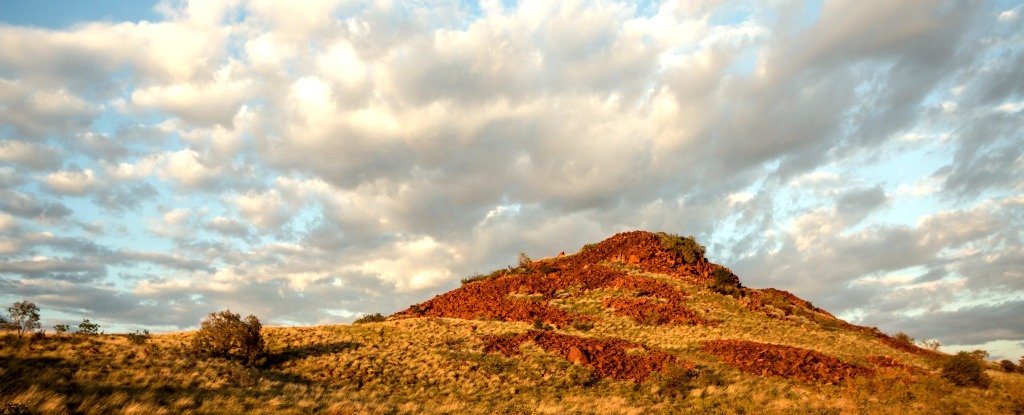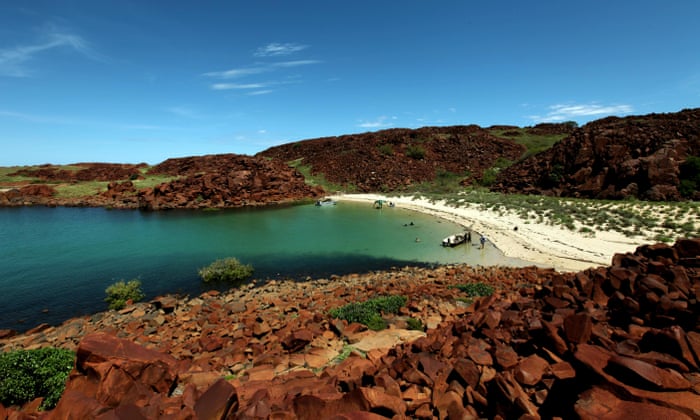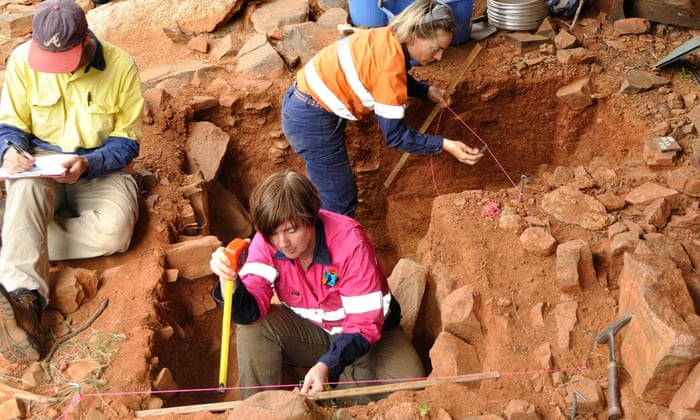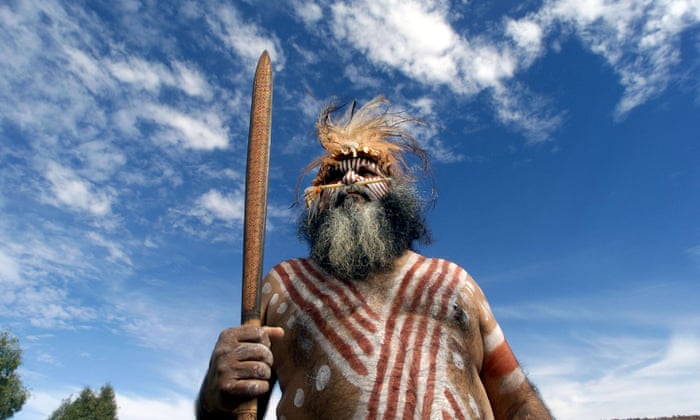The Most Ancient Civilisation on Earth
Stone houses have just been found off the coast of
Australia -
and they’re 9,000 years old

by
Jacinta Bowler
The Dampier Archipelago is a group of 42 islands, and on one of the islands, the team uncovered knee-high rock walls.
"Excavations on Rosemary Island, one of the outer islands, have uncovered evidence of one of the earliest known domestic structures in Australia, dated between 8,000 and 9,000 years ago," said lead researcher Jo McDonald, from the University of Western Australia.
"This is an astounding find and has not only enormous scientific significance, but will be of great benefit to Aboriginal communities in the area, enhancing their connections to their deep past and cultural heritage."
The researchers suggest that the structures’ inhabitants used branches or other plant material to make the roofs. The houses are also quite sophisticated, with multiple ‘rooms’.
"Inside the houses you have separate areas - it could have been a sleeping area and a working area. There is evidence of people grinding seeds on the rock floors inside the houses as well as shell food remains," McDonald told Paige Taylor from The Australian.
"We don’t really know what they were used for as these types of structures were not used in the historic periods."
This particular structure should help researchers to investigate how Aboriginal groups lived after the ice age – a time where sea levels rose 130 metres, at a rate of 1 metre every five to 10 years. This would have eventually cut the Archipelago islands off from the mainland.
"We assume they were a way of marking out social space for groups living close together as the sea level rose after the ice age, pushing groups inland into smaller territories," says McDonald.
"While these people were hunter gatherers, these structures suggest people were developing social strategies to be more sedentary, to cope with environmental change."
The team discovered the houses back in 2014, but they have only recently been dated using shells of edible mangrove gastropods found inside.
Although the researchers haven’t yet published a paper, so we can't get too excited until then, there should be more information released as the team find it, and they will hopefully publish a paper in the next few months.
Murujuga, which includes the islands and the nearby Burrup peninsula, are also hugely culturally important to the Aboriginal people in the area, and important for researchers trying to understand the past. A number of interest groups are pushing for Murujuga to become World Heritage listed.
"As well as containing more than one million rock engravings of great scientific and cultural significance, the Archipelago is home to one of the country’s largest industrial ports," McDonald said in a statement today.
She says that research from the last 12 months indicates that there was human occupation in the area dating back 21,000 years, even before the last ice age.
Just 100 km west, on Barrow Island, researchers have also found evidence of human occupation dating back 50,000 years.
According to McDonald, although there are similar structures around Australia, the houses on Rosemary Island are the oldest found.
We hope this valuable area will be protected for many years to come.
From Science Alert @
http://www.sciencealert.com/stone-houses-have-just-been-found-of-the-coast-of-australia-and-they-re-9-000-years-old
Evidence of 9,000-year-old stone houses found on Australian island
Circular
foundations excavated on Rosemary Island date to the end of the last ice age –
a time of ‘environmental stress’ for the Indigenous inhabitants

Circular stone foundations were discovered in on Rosemary Island, the outermost of 42 islands that make up the archipelago. The islands and the nearby Burrup peninsula are known as Murujuga – a word meaning “hip bones sticking out” – in the language of the Ngarluma people.
Prof Jo Mcdonald, director of the centre for rock art research and management at the University of Western Australia, said the excavations showed occupation was maintained throughout the ice age and the period of rapid rise in sea levels that followed.
The sea level on Australia’s north-west coast rose 130 metres after the end of the ice age, at a rate of about a metre every five to 10 years. “In people’s lifetimes they would have seen loss of territory and would have had to renegotiate – a bit like Miami these days,” McDonald said.
The placement of the stone structures indicated how that sudden space restriction was managed, she said. “The development of housing is really significant in terms of understanding how people actually divided up their space and lived in close proximity to each other in times of environmental stress.”
Research done in the past 12 months had found evidence of human occupation in Murujuga dating back 21,000 years, or before the last ice age, said McDonald.
Earlier research on Barrow Island, about 100km west, found evidence of human occupation dating back 50,000 years.
McDonald said the latest discovery helped build the case for the area to gain a world heritage listing.

Jo McDonald, centre, excavating at a Murujuga rock shelter in Western Australia. Artefacts uncovered in the past year show human occupation dating back 21,000 years. Photograph: University of Western Australia
It was assessed as meeting Unesco’s six world heritage criteria in 2011 but a formal nomination cannot be made without the support of the state government. The premier, Colin Barnett, said last month that the area would “probably be a world heritage site at some stage”.
“Our responsibility now is to protect these rock carvings and also make it possible for people to come and see this extraordinary place,” he said.

— Colin Barnett (@ColinBarnett) August 25, 2016
Ever seen WA's ancient rock carvings at the Burrup
Peninsula? An extraordinary place we are committed to preserve. pic.twitter.com/JFKhsM22ED
The entry to the largest heritage site, a valley containing close to a million rock carvings dating back 40,000 years, is within a kilometre of a fertiliser plant. Last year the WA government removed a large umbrella heritage listing for the peninsula because it complicated development applications.
The research done by McDonald and her team was co-funded by Rio Tinto, which has a mining lease within the national heritage area, and Murujuga Aboriginal Corporation.
McDonald said the state heritage management had been “really hotchpotch” but that existing industry could be co-managed with a world heritage site, providing suitable buffers were put in place.
Indigenous Australians most ancient civilisation on Earth, DNA study confirms
Clues left in genes of modern populations in Australian and Papua New Guinea enable scientists to trace remarkable journey made by first human explorers
A new population
analysis of Indigenous Australians and Papuans shows they can trace their
origins back to the very first arrivals on the continent about 50,000 years
ago. Photograph: Matt Turner/Getty Images
Scientists were able to trace the remarkable journey made by intrepid ancient humans by sifting through clues left in the DNA of modern populations in Australia and Papua New Guinea. The analysis shows that their ancestors were probably the first humans to cross an ocean, and reveals evidence of prehistoric liaisons with an unknown hominin cousin.
Prof Eske Willerslev, an evolutionary geneticist who led the work at the University of Copenhagen, said: “This story has been missing for a long time in science. Now we know their relatives are the guys who were the first real human explorers. Our ancestors were sitting being kind of scared of the world while they set out on this exceptional journey across Asia and across the sea.”
The findings appear in one of four major human origins papers published in Nature this week, which together give an unprecedented insight into how humans first migrated out of the African continent, splintered into distinct populations and spread across the globe.
Willerslev’s findings, based on a new population analysis of 83 Indigenous Australians and 25 Papuans, shows that these groups can trace their origins back to the very first arrivals on the continent about 50,000 years ago and that they remained almost entirely isolated until around 4,000 years ago. “They are probably the oldest group in the world that you can link to one particular place,” said Willerslev.
En route to Australia, early humans would have encountered a motley assortment of other roving hominin species, including an unknown human relative who has now been shown to have contributed around 4% to the Indigenous Australian genome. Previously, scientists have discovered that prehistoric couplings have left all non-Africans today carrying 1-6% of Neanderthal DNA.
Willerslev said the latest findings added to the view that Neanderthals and other now extinct hominins, traditionally portrayed as low-browed prehistoric thugs, were “in reality not particularly different” from our own ancestors.
Adding to this picture, a second study found that the advent of modern human behaviours around 100,000 years ago, indicated by cave art and more sophisticated tools, does not appear to have been accompanied by any notable genetic mutations.
“Your genome contains the history of every ancestor you ever had,” said Swapan Mallick, a geneticist at Havard Medical School who led the analysis of the genomes of people from 142 distinct populations.
The study also suggests that the KhoeSan (bushmen) and Mbuti (central African pygmies) populations appear to have split off from other early humans sooner than this, again suggesting that there was no intrinsic biological change that suddenly triggered human culture.
“There is no evidence for a magic mutation that made us human,” said Willerslev.
Chris Stringer, head of human origins at the Natural History Museum in London, said the findings would be controversial in the field, adding: “It either means that the behaviours were developed earlier, they developed these behaviours independently, they acquired them through exchanges of ideas with other groups, or the estimated split times are too old.”
Willerslev’s study also resolves the apparent discrepancy between genetic findings implying that Indigenous populations have been in Australia for tens of thousands of years and the fact that the languages spoken by these populations are only around 4,000 years old. “You see a movement of people spreading across the continent and leaving signatures across the continent,” said Willerslev. “That is the time that this new language has spread. It’s a tiny genetic signature. It’s almost like two guys entering a village and saying ‘guys, now we have to speak another language and use another stone tool and they have a little bit of sex in that village and then they disappear again.”
Aubrey Lynch, an Indigenous elder from the Goldfields area, said: “This study confirms our beliefs that we have ancient connections to our lands and have been here far longer than anyone else.”
From The Guardian @
https://www.theguardian.com/australia-news/2016/sep/21/indigenous-australians-most-ancient-civilisation-on-earth-dna-study-confirms
For more information about the indigenous Australians programs
see http://nexusilluminati.blogspot.com/search/label/australian%20aborigines
- Scroll down
through ‘Older Posts’ at the end of each section
Do you LIKE this uniquely informative site?
A genuinely incapacitated invalid maintains, writes, edits,
researches, illustrates, moderates and publishes this website from a tiny cabin
in a remote forest.
Now that most people use ad blockers and view these posts
on phones and other mobile devices, sites like this earn an ever shrinking
pittance from advertising sponsorship.
This site needs your help.
Like what you see? Please give
anything you can -
Contribute any amount and receive at least one New Illuminati eBook!
(You can use a card securely if you don’t use Paypal)
Please click below -
And it costs nothing
to share this post on Social Media!
Dare to care and
share - YOU are our only advertisement!
For further enlightening
information enter a word or phrase into the random synchronistic search box @
the top left of http://nexusilluminati.blogspot.com
And see
New Illuminati – http://nexusilluminati.blogspot.com
New Illuminati on Facebook - https://www.facebook.com/the.new.illuminati
New Illuminati Youtube Channel - https://www.youtube.com/user/newilluminati/playlists
New Illuminati’s OWN Youtube Videos
-
New Illuminati on Google+ @ For
New Illuminati posts - https://plus.google.com/u/0/+RamAyana0/posts
New Illuminati on Twitter @ www.twitter.com/new_illuminati
New Illuminations –Art(icles) by
R. Ayana @ http://newilluminations.blogspot.com
The Her(m)etic Hermit - http://hermetic.blog.com
DISGRUNTLED SITE ADMINS PLEASE NOTE –
We provide
a live link to your original material on your site (and links via social
networking services) - which raises your ranking on search engines and helps
spread your info further!
This site
is published under Creative Commons (Attribution) CopyRIGHT (unless an
individual article or other item is declared otherwise by the copyright
holder). Reproduction for non-profit use is permitted & encouraged - if you
give attribution to the work & author and include all links in the original
(along with this or a similar notice).
Feel free
to make non-commercial hard (printed) or software copies or mirror sites - you
never know how long something will stay glued to the web – but remember
attribution!
If you
like what you see, please send a donation (no amount is too small or too large)
or leave a comment – and thanks for reading this far…
Live long
and prosper! Together we can create the best of all possible worlds…
From the New Illuminati – http://nexusilluminati.blogspot.com

World's oldest onservatory? @ http://www.abc.net.au/news/2016-10-12/aboriginal-astronomy-provides-clues-to-ancient-life/7925024
ReplyDelete